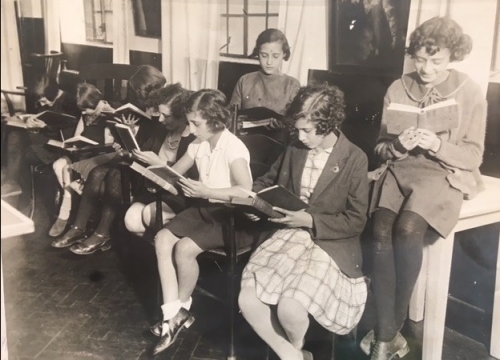To mark St George’s Day we take a look at our sources relating to the Oxford and St George’s Club which form part of the MS 132 Henriques papers.
![Jewish Settlement Annual Summer Camp, 1927 [MS132 AJ 220/2/3 f.1]](https://specialcollectionsuniversityofsouthampton.files.wordpress.com/2018/04/st-georges-day-camping-b-e1524491127469.jpg?w=500)
Jewish Settlement Annual Summer Camp, 1927 [MS132 AJ 220/2/3 f.1]
The Oxford and St George’s Club, was a Jewish youth and community centre formed by Sir Basil Henriques in the East End of London, with the aim of providing a service for local Jews of all ages.
Son of David Quizano and Agnes C. Henriques, Sir Basil Lucas Henriques, CBE, was born on 17 October 1890 in London. After completing secondary school education at Harrow, he went on to study at Oxford University, where he built his interest in philanthropy from learning about the activities of Christian groups in addressing poverty in the East End.
![Portrait of Basil Henriques, May 1906 [MS 132 AJ220/2/f1]](https://specialcollectionsuniversityofsouthampton.files.wordpress.com/2018/04/ms132_aj220_2_1_f1_henriques_portrait_may1906-edited.jpg?w=500)
Portrait of Basil Henriques, May 1906 [MS 132 AJ220/2/f1]
![The Jewish Settlement boys’ football team, 1923-4 [MS132 AJ220/2/4 f.3]](https://specialcollectionsuniversityofsouthampton.files.wordpress.com/2018/04/ms132_aj220_2_4_f3_boys_football_team_r_0001.jpg?w=500)
The Jewish Settlement boys’ football team, 1923-4 [MS132 AJ220/2/4 f.3]

Girls in the library of the Bernhard Baron St George’s Jewish Settlement, 1930s [MS 132 AJ 220/2/4 f.3.]
Through the generosity of Viscount Bearsted, adjoining houses were acquired in Betts Street after the war was over. Old Boys Clubs and Girls Clubs were started, along with Scouts, Cubs and a Synagogue founded between 1919 and 1926.
In 1929 the Clubs moved to new premises in Berners Street following the gift of £50,000 (which later rose to £65,000) provided by Mr Bernard Baron. The Bernhard Baron St George’s Settlement building opened in 1930, providing spaces for public worship, administrative offices, the infant welfare centre, the play centre, and accommodation. There was also a roller skating rink, gymnasium, library, and model laundry and kitchen.
![Programme for the opening of the Bernhard Baron St George’s Jewish Settlement, 30 June 1930 [MS 132 AJ 195/8/1 f.2]](https://specialcollectionsuniversityofsouthampton.files.wordpress.com/2018/04/img_1250.jpg?w=500)
Programme for the opening of the Bernhard Baron St George’s Jewish Settlement, 1930 [MS 132 AJ 195/8/1 f.2]
“Soon he was in a room crowded with boys, rapt in excitement over a game of ping pong. It was an inter-House match, and on its result depended the winning of the cup, which each month was awarded to the House which had won the most points by entering the greatest number of fellows in the various classes held in the Club. A class for which you had to change into kit counted two points – gym., P.T., running, boxing or football, whilst the others- debates, chess, general information, literature, dramatic or drawing – counted one point for the House.”
The Henriques papers provide a wealth of information on the Oxford and St George’s Club and its development through time. Documents include correspondence, pamphlets, reports and an extensive collection of photographs.
![Boys boxing in the roof playground of the Bernhard Baron St George’s Jewish Settlement, 1930s [MS 132 AJ 220/2/4 f.3]](https://specialcollectionsuniversityofsouthampton.files.wordpress.com/2018/04/boxing.jpg?w=500)
Boys boxing in the roof playground of the Bernhard Baron St George’s Jewish Settlement, 1930s [MS 132 AJ 220/2/4 f.3]
Due to decline in membership, the activities of the Settlement have ceased and it is now a grant making organisation.
More information about the organisation can be found here: http://www.oxfordandstgeorges.com/index.html




![Men's football team, 1953-4 [photo_MS1_7_291_22_4] Men's football team, 1953-4 [photo_MS1_7_291_22_4]](https://live.staticflickr.com/65535/50089268168_f26eed63ef_s.jpg)
![Women's rowing team, 1961-2 [MS1_7_291_22_4] Women's rowing team, 1961-2 [MS1_7_291_22_4]](https://live.staticflickr.com/65535/50090079577_3b7acbde42_s.jpg)
![Men's rugby team, 1953-4 [MS1_7_291_22_4] Men's rugby team, 1953-4 [MS1_7_291_22_4]](https://live.staticflickr.com/65535/50089268523_4f2c587220_s.jpg)
![Women's hockey team, 1953-4 [MS1_7_291_22_4] Women's hockey team, 1953-4 [MS1_7_291_22_4]](https://live.staticflickr.com/65535/50090079692_28114e9c7d_s.jpg)